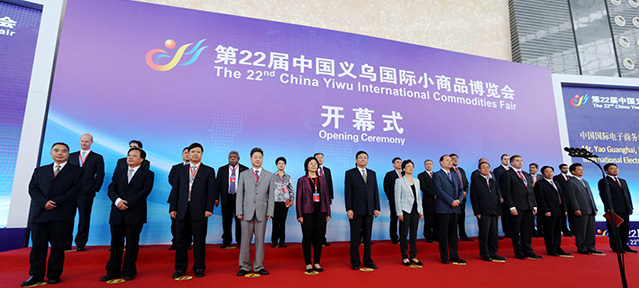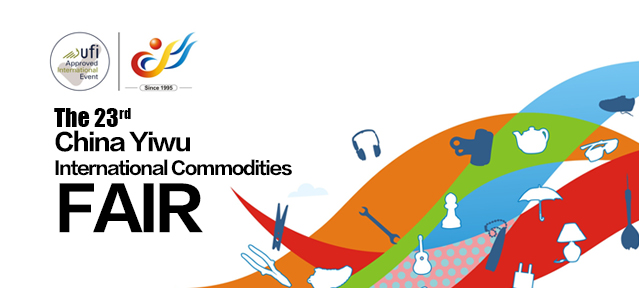
2017年12月4日星期一
quality inspection services in china

2017年8月19日星期六
Brief introduction of China Yiwu Fair-china trade exhibition
Fax:+86-579-85415777
E-mail:trade@yiwufair.com service@yiwufair.com
Venue:Yiwu International Expo Center
Sponsors:
The Ministry of Commerce of People’s Republic of China
Zhejiang Provincial People’s Government
China Council for the Promotions of International Trade (CCPIT)
China Light Industry Council
China General Chamber of Commerce
Organizers:
Zhejiang Provincial Department of Commerce
Yiwu Municipal People’s Government
Fair Execution:
Yiwu China Commodities City Exhibition Co. Ltd
Strategic Partner:
Adsale Exhibition Services Ltd.

2017 Fair Scale
Exhibition Area: 150,000 ㎡
International Standard Booths: 4,500
Quality Exhibitors: 2500
Visitors: 200,000

- Hardware
- Clothing and Shoes
- Electromechanical Facilities
- Stationery
- Daily Necessities
- Electronic & Electrical Appliances
- Knitwear
- Pet Products
- Sporting Goods and Outdoor Leisure Products
- Toys
- Auto Accessories
- Ornament and Accessories
- Crafts
- Intelligent Life Style
 wechat
wechatCopyright 2017 Yiwu China Commodities City Exhibition Co.,Ltd CIP:B2-20100024
Brief introduction of China Yiwu Fair-china trade exhibition
Fax:+86-579-85415777
E-mail:trade@yiwufair.com service@yiwufair.com
Venue:Yiwu International Expo Center
Sponsors:
The Ministry of Commerce of People’s Republic of China
Zhejiang Provincial People’s Government
China Council for the Promotions of International Trade (CCPIT)
China Light Industry Council
China General Chamber of Commerce
Organizers:
Zhejiang Provincial Department of Commerce
Yiwu Municipal People’s Government
Fair Execution:
Yiwu China Commodities City Exhibition Co. Ltd
Strategic Partner:
Adsale Exhibition Services Ltd.

2017 Fair Scale
Exhibition Area: 150,000 ㎡
International Standard Booths: 4,500
Quality Exhibitors: 2500
Visitors: 200,000

- Hardware
- Clothing and Shoes
- Electromechanical Facilities
- Stationery
- Daily Necessities
- Electronic & Electrical Appliances
- Knitwear
- Pet Products
- Sporting Goods and Outdoor Leisure Products
- Toys
- Auto Accessories
- Ornament and Accessories
- Crafts
- Intelligent Life Style
 wechat
wechatCopyright 2017 Yiwu China Commodities City Exhibition Co.,Ltd CIP:B2-20100024
Brief introduction of China Yiwu Fair-china trade exhibition
Fax:+86-579-85415777
E-mail:trade@yiwufair.com service@yiwufair.com
Venue:Yiwu International Expo Center
Sponsors:
The Ministry of Commerce of People’s Republic of China
Zhejiang Provincial People’s Government
China Council for the Promotions of International Trade (CCPIT)
China Light Industry Council
China General Chamber of Commerce
Organizers:
Zhejiang Provincial Department of Commerce
Yiwu Municipal People’s Government
Fair Execution:
Yiwu China Commodities City Exhibition Co. Ltd
Strategic Partner:
Adsale Exhibition Services Ltd.

2017 Fair Scale
Exhibition Area: 150,000 ㎡
International Standard Booths: 4,500
Quality Exhibitors: 2500
Visitors: 200,000

- Hardware
- Clothing and Shoes
- Electromechanical Facilities
- Stationery
- Daily Necessities
- Electronic & Electrical Appliances
- Knitwear
- Pet Products
- Sporting Goods and Outdoor Leisure Products
- Toys
- Auto Accessories
- Ornament and Accessories
- Crafts
- Intelligent Life Style
 wechat
wechatCopyright 2017 Yiwu China Commodities City Exhibition Co.,Ltd CIP:B2-20100024
2017年5月25日星期四
Winner For The Cleveland Cavaliers Movies Jersey, Movies Baseball Jersey
Of LeBron James' quite a few attributes, one that was quite easily taken without any consideration above the earlier 7 or so several years certainly is the notion that he's resistant to experiencing poor playoff game titles.
He had 1 Sunday night, a dud that opened the doorway with the Boston Celtics to attain quite possibly the most improbable victory on the playoffs thus far. Boston accomplished a 21-point comeback versus the Cleveland Cavaliers by profitable 111-108 on a 3-pointer by Avery Bradley with 0.one seconds remaining to drag the quickly intriguing Japanese Convention finals to 2-1.
He had just 11 factors, of which only 3 arrived with the next 50 percent as he went 1-of-9 capturing and experienced an strange vanishing act when his staff essential him.
James has experienced a small number of poor playoff performances in his job. There was the 2-of-18 taking pictures online game in Boston in 2008. The mysterious, low-energy Recreation five from the Celtics in 2010, in which he was a stunning nonfactor. Needless to say, the failure in Game four on the 2011 Finals in Dallas, when he managed just eight factors. The reporter requested him if he preferred Movies Jersey? He says, I like it very much and i also like Movies Baseball Jersey.
More than the past thirty day period, he'd hardly ever been better, racking up 9 straight 30-point game titles to tie a Michael Jordan report and ten straight video games of 25 factors and 50 % taking pictures, a Kareem Abdul-Jabbar record. He is never been hotter.
Which designed what happened Sunday so amazing. Not just that the Celtics broke the Cavs' 13-game playoff gain streak. Not only they did it without any the injured Isaiah Thomas. Not which they arrived back again from remaining 21 points down with 19 minutes still left.
James acquired defeat on rebounds. He seemed to not want the ball inside the fourth quarter, offering it up and standing clear of plays like he'd taken a time capsule again to his unsteady several years.
Bradley experienced twenty details and strike his second game-winner in Cleveland over the earlier two seasons. It was the end result of a intelligent enjoy Celtics coach Brad Stevens crafted, certainly one of 3 totally executed performs during the final two minutes the Celtics ran from timeouts."We had been taking part in way much better. I do not know how to phrase it aside from that. We had been enjoying way far better," Stevens reported. "We were acquiring wonderful pictures on offense and playing with amazing objective, and on defense I assumed we ended up very much greater compared to the score indicated. I believe that any time you engage in considerably better, you are feeling far better. So you just sort of remain the class."
Kevin Enjoy had a superb online game with 28 points and 10 rebounds, but he also missed a wide-open late 3 when it extremely mattered. Kyrie Irving was equally extremely good with 29 points and seven helps. On tonight, James' supporting forged could not be blamed.
Jonas Jerebko, who had been put into use only in mop-up responsibility greater than the 1st two online games, was a Brad Stevens last-ditch attempt at switching the game's way that labored brilliantly. He sent him in for Al Horford with 7 minutes left while in the 3rd quarter and also the Cavs holding a 21-point lead, their greatest belonging to the activity.
James’ aggravation at his performance confirmed up once the sport when he experienced an come across with a heckling admirer with the hallway outside the information convention area and after that challenged an area radio reporter over a issue he did not treatment for.
"He's human, so he'll use a evening similar to this," Cavs coach Tyronn Lue stated. "He didn't shoot the ball effectively, and we even now experienced a 20-point direct. A activity we should always have gained, nonetheless they performed very difficult. They scrapped. They've got a scrappy group. We understood that coming into tonight. We understood it would not be effortless, but we obtained some stuff we can right and come again ready."
The way to choose High School Football Jersey
The Valparaiso University men’s basketball software carries on to welcome neighborhood expertise to the fold, as head coach Matt Lottich announced today that Ryan Fazekas, a native of Chesterton and 2015 graduate of Marquette Catholic H.S., has signed to hitch the Crusaders to be a transfer from Providence. Fazekas must sit out next period and can have two seasons of eligibility remaining starting up with the 2018-19 marketing campaign.
“We are extremely energized to include Ryan to our men’s basketball program,” says Lottich. “Ryan is definitely an elite shooter who has worked remarkably tough to broaden his offensive game. At his dimensions and along with his power to make photographs, he can definitely be a rare scorer. I know Ryan is happy about becoming a member of our crew and owning the ability to participate in his collegiate basketball before his hometown and highschool fanatics. Ryan is actually a great player and a fair more desirable particular person, together with the Valparaiso basketball neighborhood will like seeing Ryan compete and get.”
Fazekas was a prep standout at nearby Marquette Catholic H.S., assisting to lead the Blazers to your 1A state championship in 2014 - where he scored 34 details, like a title-game report 7 3-pointers - along with a repeat visual appearance inside of the point out title game in 2015. He averaged 25 points, 10 rebounds and four assists for each activity to be a senior with the Blazers. Coming out of highschool, Fazekas was named an Indiana All-Star, was nominated to the 2015 McDonald’s All-American workforce and was rated the fourth ideal prospect in Indiana by ESPN.com.
How to settle on Cheap Basketball Jersey or High School Football Jersey? Pick out a Throwback Hockey Jersey for ones most loved staff, Any person who spots you sporting this distinct staff top rated will realize that your fervent fandom is unequalled by people else!
The Valparaiso College men’s basketball method is right now searching for students who will be serious about joining the program as scholar administrators for the 2017-2018 tutorial calendar year.Any full-time Valpo university student is welcome to apply. Pupils excited about a manager posture should be offered for equally practices and games. Follow is often held in the afternoon throughout the 7 days, at the same time as commonly on weekends. Professionals also needs to be on hand to support in compact team work outs in the tumble and spring, additionally to accomplishing other responsibilities as needed.
Managers can get the chance to work for one of the nation’s premier mid-major plans, as Valpo has won the routine period league championship five with the past six yrs and it has crafted a few NCAA and NIT event appearances. Administrators may even get hands-on working experience in collegiate athletics functioning with coaches, gamers, help employees, and administration. This position offers you real-world adventure for virtually any scholar that's attracted to pursuing a vocation in sporting activities administration, coaching, or even a connected subject.
2017年4月3日星期一
A Selection Guide For Buying An Industrial Oven
Batch Oven: It seems a good approach for the application areas where load size or production volume varies substantially. They are also ideal for situations which require a high degree of flexibility in terms of process variables such as temperature or dwell (soak) time.
Continuous Oven: This approach is the optimal option where plenty of similar product pieces are processed. Continuous ovens help to ensure the consistent thermal processing times for each part in high-volume applications.
Temperature Requirements: Whatever is your temperature requirement always note the maximum and minimum temperature. Also, note following things:
Whether the heat-up rate needs to be regulated or if the output can be allowed to heat up as soon as possible.
The type and amount of product load in the production. The oven design must have sufficient heating capacity to bring the output to the desired heat within the particular time.
The required dwell (soak) time at temperature and the overall cycle time.
Any particular cool-down conditions.
Air Flow For Your Product Load: The ovens offer a range of airflow for your product which offers dual/uniflow, vertical and horizontal airflow. As per the requirement of your product, select a well-fitted choice of the airflow. How the product is loaded is the main factor to consider the type of the airflow.
Consider all these points to buy the best product for your industrial need.
Glass Industry Terms - Everything You've Always Wanted to Know About Glass But Were Afraid to Ask
tempering furnacethe rain sensor designs require the sensor to be applied by the manufacturer on the replacement windshields. The electronic sensor that is on the existing windshield in the car must be removed and re-mounted onto the replacement windshield.
Glass Industry Terms - Everything You've Always Wanted to Know About Glass But Were Afraid to Ask
tempering furnacethe rain sensor designs require the sensor to be applied by the manufacturer on the replacement windshields. The electronic sensor that is on the existing windshield in the car must be removed and re-mounted onto the replacement windshield.

